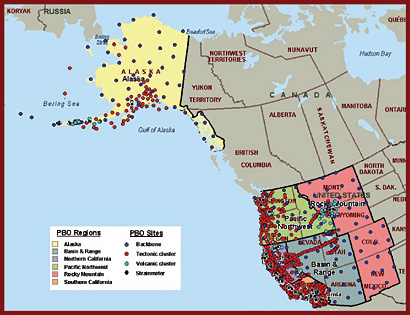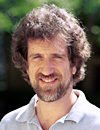Stanford Report, Jan. 13, 2004
Observatory promises data
of 'unprecedented accuracy' at tectonic boundary
National Science Foundation project will
eventually include 800 monitoring stations on active faults in 12
western states
BY GEOFF KOCH
To geophysics Professor Paul Segall, the recent decision by the National Science Foundation (NSF) to build a tectonic plate observatory across North America represents the opportunity of a lifetime.
Known as the Plate Boundary Observatory (PBO), the five-year $100 million NSF-funded project is designed to study strain and other geological forces along the active boundary between the Pacific and North American plates. When completed, PBO will consist of some 800 permanent Global Positioning System (GPS) monitoring stations and approximately 200 extremely sensitive borehole strainmeters deployed across Alaska and 11 other western states -- particularly near active faults and volcanoes.

Some 800 global
positioning system stations will be deployed for the observatory.
Above, a GPS station is installed in Southern California.
Courtesy:
EarthScope/USGS
"This kind of thing happens once in a career," says Segall, who chairs the PBO advisory board that will determine how these instruments will be deployed.
PBO represents about half of the budget for EarthScope, a $219 million project launched by NSF last year to help scientists answer fundamental questions about the structure and evolution of the North American continent. Two other EarthScope projects are the San Andreas Fault Observatory at Depth (SAFOD), a 2.4-mile-deep seismic observatory jointly managed by Stanford and the U.S. Geological Survey, and USArray, a large network of seismic instruments that will study the Earth's crust and upper mantle.
In a recent press release, NSF officials noted that EarthScope was launched exactly 200 years after the Lewis and Clark expedition: "This time, however, instead of toting sextants and compasses to map the surface, scientists will bring seismometers, state-of-the art drilling equipment, satellites and Global Positioning System receivers to map Earth's interior."
Boundary violence
Tremendous violence occurs at the boundary between the Pacific and North American plates of the Earth's crust. As they come together near the West Coast, the plates continuously smash into each other in slow motion -- a process that has been going on for millions of years and has given rise to many prominent features of the North American landscape, including the San Andreas Fault and the Cascade Mountains.
This boundary will be the focus of PBO. "It is where the action is," Segall says.

Hundreds of Global Positioning
System stations and extremely sensitive borehole strainmeters will
be installed in 12 western states, especially near active faults
and volcanoes. Courtesy:
EarthScope
The grinding action generates subtle deformation across the continent. Eventually, hundreds of sensors will be in place to measure this deformation and help geologists understand the shifting strains in the ground. But first, Segall and his colleagues need to answer some questions, including two that were discussed at the annual fall meeting of the American Geophysical Union (AGU) in San Francisco last month.
Setting up sensors, reading results
Lest they be accused of not being creative, consider how geologists usually decide where to place expensive equipment such as GPS receivers.
"Typically, it is by gut feel," Segall says.
In a project compared to Lewis and Clark's Corps of Discovery, gut feel just won't do. So Segall, Stanford graduate student Jessica Murray and David Schmidt, a former Stanford postdoctoral fellow now at the University of Oregon, built mathematical models to figure out exactly how these sensors should be arrayed across the landscape. It's a good thing they did. Their models ensured the network would be optimized, particularly in seismically active areas.
Segall compared the work to that of astronomers who design telescopes. Stargazers pick one type of instrument to look at objects nearby in the solar system and another type to peer into deep space, he said. Similarly, the sensors might be set up differently depending on the specific seismic effects, depths and time scales his colleagues are interested in. The models that Schmidt presented at the December AGU conference were designed to make it easier for competing research interests to compromise, according to Segall.
Another fundamental issue facing researchers is how to interpret the data returned by the sensors -- an analog to the age-old problem in science of distinguishing signal from noise. Devices called strainmeters that measure deformation deep in the Earth are planned for use in the project.
But the devices are very sensitive. "They feel everything," Segall explained, and make it difficult to determine if the data represent widespread aftereffects of a volcanic eruption or a small, insignificant crack appearing in the rock near the device itself.
At the AGU conference, Segall described the challenges of understanding the data returned by these devices. Given that PBO sensors are scheduled to be installed early next year, there is urgency behind this math-heavy topic.
"There are only a few dozen strainmeters around the world today, but we are set to install around 200 of them," he noted. "PBO scientists will be able to monitor activity at North America's plate boundaries with unprecedented accuracy at periods ranging from the seconds it takes for small earthquakes to rupture to the decades it takes for magma to accumulate beneath volcanoes."
Segall won't be the only one participating in this once-in-a-career event. According to NSF, all EarthScope data will be made available in close to real time on the web for the benefit of academics and amateurs alike.
Well-water studies
During the AGU conference, Segall also discussed his recent research on earthquakes in Iceland. Working with scientists from Harvard University and the National Energy Authority in Iceland, Segall compared how subtle deformations at ground level and in water levels in wells changed over time following an earthquake.
Segall used a unique combination of new and old technology. Color-coded satellite radar images revealed subtle motions of the crust after the quake, while well monitors determined the height of water in geothermal water wells that dot the Icelandic landscape. He found a clear correlation between the two sets of data. In effect, the shifting water levels revealed the shifting stresses in the Earth's crust following the quakes.
Gilles Peltzer, a geologist at the University of California-Los Angeles and NASA's Jet Propulsion Laboratory, said the results might have a practical use.
"One of the main concerns after a major earthquake is the possible triggering of other earthquakes on nearby faults," Gilles said. "Understanding how the stress is modified on adjacent faults has direct implications on risk assessment after an event."
Segall's Icelandic results are described in the July 10 issue of the journal Nature.
Geoff Koch is a Stanford University graduate student in journalism. SR
Web Links
Relevant Web URLs:
http://pangea.stanford.edu/research/CDFM/paul/
http://www.earthscope.org
http://www.agu.org

Paul Segall
![]()
